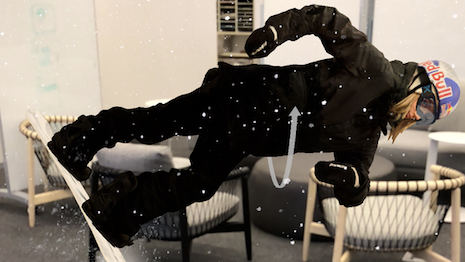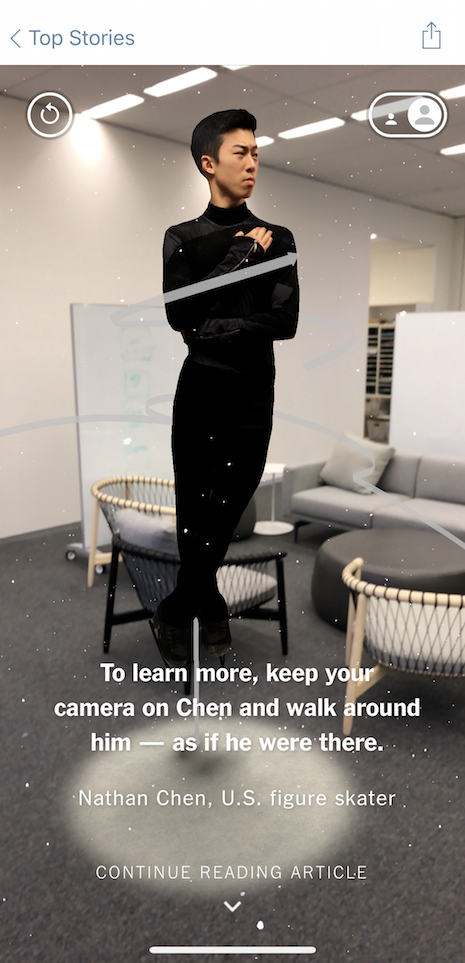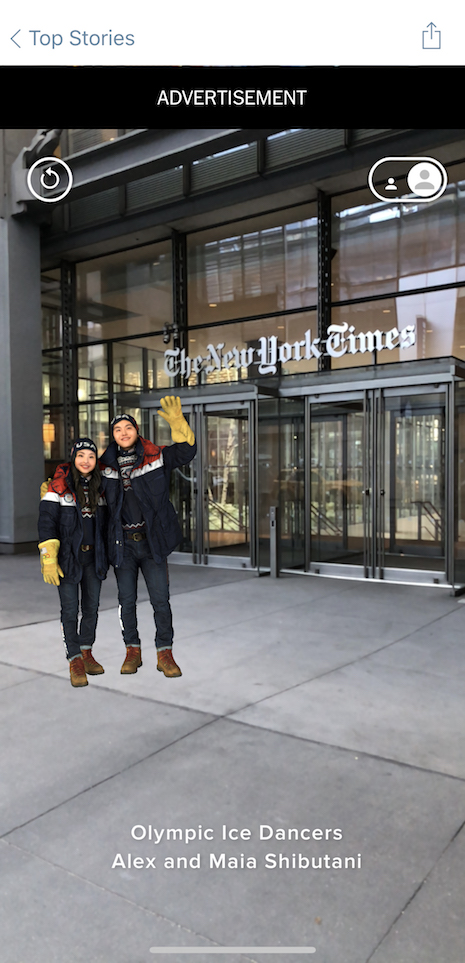 The New York Times' AR experience puts Olympic athletes wherever consumers are. Image courtesy of The New York Times
The New York Times' AR experience puts Olympic athletes wherever consumers are. Image courtesy of The New York Times
U.S. fashion label Ralph Lauren is giving consumers an up-close look at the prowess of Olympic athletes through a sponsored augmented reality experience.
Produced by New York Times journalists, the interactive content allows readers to walk around the figures of skaters and a snowboarder, highlighting their form. Marking the first time the media company has leveraged AR, this editorial effort aims to provide a more immersive storytelling experience.
The New York Times was reached for comment.
Augmented athletes
The New York Times’ AR experience can be viewed on a smartphone or tablet through the publication’s mobile application. The technology, which uses Apple’s ARKit, integrates with a device’s camera to blend the real and the virtual.
To create an augmented reality versions of the athletes, The New York Times took 3D scans of them in a static pose. The model was then repositioned.
In the enhanced article, readers meet American figure skater Nathan Chen. After discussing his feat of landing four quadruple jumps in a program, the experience allows consumers to view his form as he is mid-air.
Screenshot of The New York Times' AR experience. Image courtesy of The New York Times
After waving their phone over a flat surface, consumers can “place” the skater’s likeness there. Once positioned, the reader can step around the frozen athlete, getting a better feel for his trajectory.
Next, the article introduces speed skater J.R. Celski, who demonstrates how low athletes in this sport keep to the ice, using their hands for added stability. As the consumer walks around the skater as if walking out on the ice, the AR experience gives extra details, such as noting the plastic tips on his gloves to protect his hands as he makes turns.
Hockey goalie Alex Rigsby is shown catching a puck in her glove, demonstrating how wide players attempt to make their hand to increase the area and increase the chances of a save.
Austrian snowboarder Anna Gasser is featured executing a complex jump. Creating an idea of distance, a reader can walk the 60 total feet she travels.
Within the article is a Ralph Lauren advertisement, which features an Olympian from the U.S. team talking about the journey to the Games.
There is also a feature of U.S. ice dancers Alex and Maia Shibutani wearing the opening ceremony uniforms designed by Ralph Lauren. The apparel label is returning as the official outfitter of Team USA for the Olympic and Paralympic games in Pyeongchang.
The experience includes an ad for sponsor Ralph Lauren. Image courtesy of The New York Times
“In continuing to explore and support innovation across all aspects of our business, we partnered with The New York Times to launch the cutting-edge Olympics AR experience,” said David Lauren, chief innovation officer at Ralph Lauren, in a statement. “Ralph Lauren is an official Outfitter of Team USA and we’re excited to build innovative ideas that bring the Olympics to life for the consumer in new and exciting ways.”
While sponsored by Ralph Lauren, the AR experience lives inside The New York Times’ news feed. In addition to the branded AR experience produced by The New York Times' experiential agency Fake Love, the publisher’s T Brand Studio worked with Ralph Lauren on the creative design and concept.
In addition to iOS devices, the media company plans to roll out AR experiences to Android devices using ARCore in the near future.
Immersive storytelling
Following a flood of virtual reality campaigns, the use of augmented reality has also picked up as brands look to connect the digital and the physical.
Department store chain Saks Fifth Avenue, for instance, is helping to usher in a futuristic payment solution using augmented reality.
Mastercard has worked with Osterhout Design Group and Qualcomm Technologies to develop an AR payment program debuting with Saks. The solution will allow for shoppers to gain greater insight on products and recommendation but will also authorize payments through eyeball scanning (see story).
While AR has been incorporated into consumer-facing experiences, the technology is also finding a place behind the scenes.
German automaker Porsche’s U.S. importer is using augmented reality to aid remote assistance for its service technicians. Porsche Cars North America’s “Tech Live Look” employs smart glasses with a built-in camera and LED light, allowing workers to take and share images and video from their perspective (see story).

